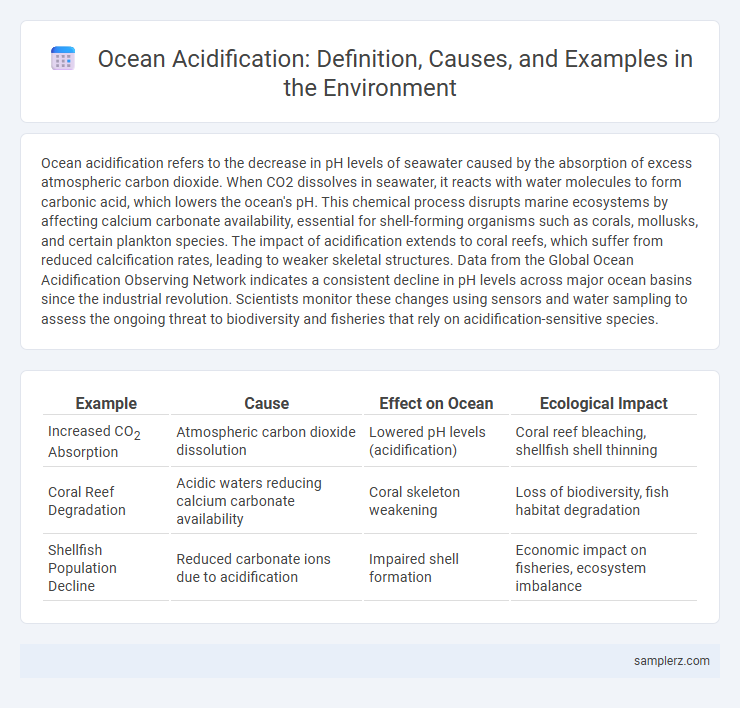Ocean acidification refers to the decrease in pH levels of seawater caused by the absorption of excess atmospheric carbon dioxide. When CO2 dissolves in seawater, it reacts with water molecules to form carbonic acid, which lowers the ocean's pH. This chemical process disrupts marine ecosystems by affecting calcium carbonate availability, essential for shell-forming organisms such as corals, mollusks, and certain plankton species. The impact of acidification extends to coral reefs, which suffer from reduced calcification rates, leading to weaker skeletal structures. Data from the Global Ocean Acidification Observing Network indicates a consistent decline in pH levels across major ocean basins since the industrial revolution. Scientists monitor these changes using sensors and water sampling to assess the ongoing threat to biodiversity and fisheries that rely on acidification-sensitive species.
Table of Comparison
| Example | Cause | Effect on Ocean | Ecological Impact |
|---|---|---|---|
| Increased CO2 Absorption | Atmospheric carbon dioxide dissolution | Lowered pH levels (acidification) | Coral reef bleaching, shellfish shell thinning |
| Coral Reef Degradation | Acidic waters reducing calcium carbonate availability | Coral skeleton weakening | Loss of biodiversity, fish habitat degradation |
| Shellfish Population Decline | Reduced carbonate ions due to acidification | Impaired shell formation | Economic impact on fisheries, ecosystem imbalance |
Causes of Ocean Acidification
Increased carbon dioxide emissions from burning fossil fuels dissolve into ocean water, forming carbonic acid that lowers pH levels and causes ocean acidification. Agricultural runoff containing nitrogen and phosphorus exacerbates this process by promoting algal blooms, which consume oxygen and release carbon dioxide during decomposition. Deforestation reduces terrestrial carbon absorption, increasing atmospheric CO2 concentrations and amplifying the acidification of marine ecosystems.
Chemical Processes Behind Acidification
Ocean acidification occurs as seawater absorbs excess atmospheric carbon dioxide (CO2), leading to the formation of carbonic acid through the chemical reaction CO2 + H2O - H2CO3. This carbonic acid dissociates into bicarbonate (HCO3-) and hydrogen ions (H+), increasing the ocean's acidity and lowering pH levels. The rise in hydrogen ion concentration interferes with marine organisms' ability to form calcium carbonate shells and skeletons, disrupting vital biological and ecological functions.
Impact on Coral Reefs
Ocean acidification, driven by increased CO2 absorption, reduces carbonate ion concentration essential for coral calcification, weakening coral skeletons. This process disrupts reef architecture, leading to diminished biodiversity and compromised habitats for marine species. The decline in coral health also affects fisheries and coastal protection, highlighting the ecological and economic consequences of acidification-driven reef degradation.
Effects on Marine Biodiversity
Ocean acidification caused by increased carbon dioxide absorption lowers seawater pH, disrupting calcium carbonate formation critical for coral reefs and shellfish. This chemical imbalance reduces biodiversity by threatening calcifying organisms and coral reef ecosystems that serve as habitats for numerous marine species. Declines in these populations cascade through food webs, impairing fisheries and overall ocean health.
Acidification and Shellfish Decline
Ocean acidification, driven by increased CO2 absorption, lowers seawater pH and reduces carbonate ion availability essential for shell formation in marine organisms. Shellfish such as oysters, clams, and mussels experience weakened shells and reduced growth rates, leading to population declines and disrupted marine ecosystems. Studies indicate that continued acidification threatens shellfish fisheries, affecting food security and coastal economies worldwide.
Regional Hotspots of Ocean Acidification
Regional hotspots of ocean acidification such as the Arctic Ocean, the North Atlantic, and the coral reefs of the Great Barrier Reef experience accelerated pH declines due to higher CO2 absorption and local stressors like temperature rise and pollution. These areas face significant impacts on marine biodiversity, including coral bleaching, shellfish weakening, and disrupted food webs. Monitoring these hotspots is critical for targeting mitigation efforts and protecting marine ecosystems sensitive to acidification.
Socioeconomic Consequences for Fisheries
Ocean acidification, driven by increased CO2 absorption, disrupts marine ecosystems and threatens shell-forming species crucial for fisheries. This chemical alteration leads to reduced fish populations and compromised livelihoods for coastal communities dependent on fishing industries. Economic losses in fisheries can ripple through global markets, affecting food security and employment in vulnerable regions.
Research Case Studies on Ocean Acidification
Research case studies on ocean acidification reveal significant impacts on marine ecosystems, such as coral reef degradation and shellfish vulnerability due to increased CO2 absorption lowering seawater pH. Experiments conducted in the Pacific Ocean demonstrate altered calcification rates in mollusks and reduced biodiversity in affected zones. Long-term monitoring highlights the urgency for mitigation strategies aimed at reducing carbon emissions and protecting oceanic habitats.
Mitigation Strategies and Solutions
Mitigation strategies for ocean acidification include reducing CO2 emissions by transitioning to renewable energy sources and implementing carbon capture technologies. Enhancing marine ecosystem resilience through the restoration of seagrass beds and mangroves helps absorb CO2 and buffer pH levels. Policy measures that enforce emission reductions and support international cooperation are critical to limiting acidification impacts on marine biodiversity.
Future Projections and Global Implications
Ocean acidification is projected to intensify by 2100 due to increasing atmospheric CO2 levels, with models predicting a 100-150% increase in hydrogen ion concentration compared to pre-industrial times. These changes threaten marine ecosystems, particularly coral reefs and shellfish, compromising biodiversity and fisheries that support global food security. Widespread acidification could disrupt carbon cycling and reduce the ocean's capacity to act as a carbon sink, exacerbating climate change impacts globally.

example of acidification in ocean Infographic
 samplerz.com
samplerz.com